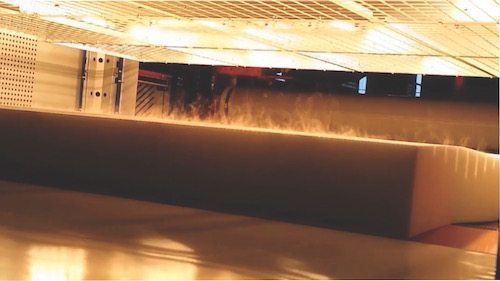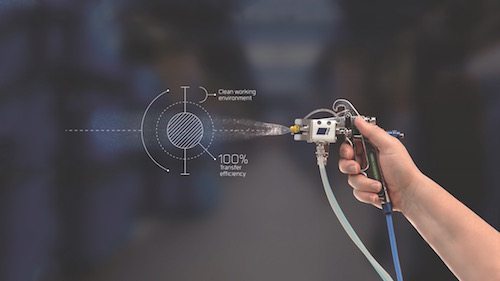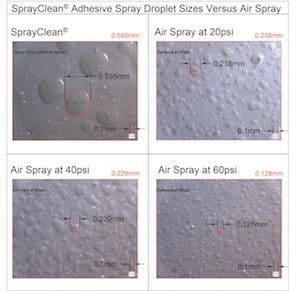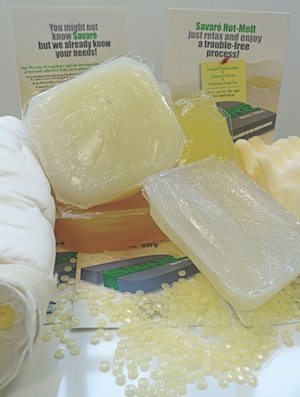Seal of approval
BY BETH ENGLISH AND JASON SCHNEIDER
When it comes to putting a mattress together, adhesives play an essential role in making things stick.
But, in recent years, changes in mattress construction have required adhesives to change their tack. Mattress components now are more varied than ever and bed makers have come to depend on two main classes of glues—water-based and hot melt—to hold it all together.

The Sababond 2611, introduced by Kimball, Michigan-based SABA North America in 2014, is a heat-activated rollable, complemented by an infrared drying process that makes it possible to immediately roll-pack a mattress.
“Adhesive chemistries for applications in mattress manufacturing have come a very long way in the last 20 years,” says Steve Adams, business manager for UPACO Foam Fabricating Adhesives Group in Richmond, Virginia.
UPACO, which is a division of Nashua, New Hampshire-based Worthen Industries, has worked with foam suppliers and mattress manufacturers to develop a line of hot melts and water-based adhesives that meet these new challenges in mattress manufacturing, Adams adds.
Whether one-component or two-component chemistries, roll-on or sprayable applications, today’s improved adhesives offer faster dry times, better bonding strength, cost efficiencies, improved flexibility and increased application ease, industry suppliers say.
These improvements couldn’t come at a better time.

Simalfa’s Overspray Free line of products dispense adhesives in a web-like pattern instead of a traditional water-based adhesive spray pattern. The Hawthorne, New Jersey-based company touts its Overspray Free line as an innovation that offers instant tack and fast drying, while eliminating overspray through chemistry, both one- and two-part formulations.
“The industry has moved from simple spring construction to foam encasement and all-foam builds with more complex combinations that require more gluing—we’re also seeing more automation,” says Harry Bajakian, national sales manager for Hawthorne, New Jersey-based Simalfa.
Jim Turner, president of SABA North America, headquartered in Kimball, Michigan, agrees that mattress construction and components are changing. “There’s been a major increase in the roll-coating process and more all-foam units. There are new fibers and foam types, which are more difficult to bond.”
Speed stick
Of major importance is the need for speed.
The increased use of foam comfort layers in beds, the rising popularity of all-foam models and the intense competition within this just-in-time industry has heightened the demand for fast-curing glues. They help manufacturers move product rapidly off the production floor and into roll-pack or bagging machines—and onto the delivery truck, en route to customers.
When it comes to speed, the latest water-based formulations give hot melts a run for their money and are more fast-drying than ever. But the two glues have their own distinct uses in mattress and foundation construction, suppliers say.
The newest hot-melt adhesives continue to be popular for bonding foams, pocket coil assemblies, fabrics and fibers, says Friederich Braetzkus, director of product management at Jowat Corp., based in Archdale, North Carolina.
“Hot melts can be desirable for their fast holding power, no need for drying and their lack of overspray,” UPACO’s Adams says. “However, hot melts typically do not perform well with viscoelastic or gel foams. Also, improperly formulated hot melts can be considered ‘noisy’ as they can make a crackle sound when the consumer moves on a mattress while sleeping.”
What’s in store for the future? Ever faster, automated production lines.

With its mattress-build adhesive testing laboratory in Richmond, Virginia, UPACO chemists can test new adhesive formulations for initial strength, fast dry rate and permanent bonds.
“We have noticed an increasing interest in the automation process, as well as the development of innovative materials that might be very challenging to bond, (such as) foams with phase-change material and pocketed microcoils, etc.,” says Paolo Campitelli, U.S. sales and technical service manager for Milan-based Savare Specialty Adhesives.
“Our remarkable experience with automatic gluing lines in Europe has been a key factor to help our U.S. customers in the automation process, while our top-performance products have proven to have excellent bonding strength with the most challenging substrates,” Campitelli added.
Adhesives suppliers predict that, whether manufactured on an automated production line or hand assembled and sprayed, the demand for compressed and roll-packed mattresses will continue to grow, and, with that, the need for a high-tack, flexible bond with quick drying times will continue.
“It’s a logistical efficiency,” SABA’s Turner says. “I think the growing e-commerce segment is a great business model, and I believe we’ll start to see more roll-packed mattresses at the retail level. Why deliver a bulky mattress when you can throw one in the back of someone’s trunk?”
Water-based new wave
Water-based adhesive suppliers promote recent product innovations, which focus on faster dry times and innovative application methods that are faster and more economical.
Simalfa has more than 150 formulations to choose from, along with a variety of application methods. Specializing in water-based adhesives, the company touts its Overspray Free line of products as an innovation that offers instant tack and fast drying, while eliminating overspray through chemistry (both one- and two-part formulations).
Instead of applying adhesives in a mist pattern, the Overspray Free adhesives are dispensed in a web-like pattern.
“These proprietary formulations do not require any specialized spray guns or delivery systems and remove all operator and equipment variables that contribute to overspray,” Bajakian says. “We’ve also been focusing on adhesives that complement automation and can do historically nontraditional things like achieving an extraordinary instant bond while only being applied via one-sided application. This takes less time, simplifies the adhesive application in an automated environment and allows the line to move much faster.”
Bajakian says Simalfa anticipates a continued boom in online foam mattress sales and will present new products at ISPA EXPO that address those needs. “There’s really nothing in a mattress plant we can’t do. Simalfa can be used for foam-encased, all-foam, pillow-top and quilter applications.”
SABA is introducing two new rollable adhesives with high-assembly tack this month.
“It has unbelievable initial tack,” Turner says. “You can build a foam-encased mattress via a roll-coating process and the initial adhesive strength will hold. It’s never been done before.”
The product will use up to 50% less adhesive than typical roll-coat products, which, while it doesn’t eliminate dry time, does reduce it significantly. It also presents a cost savings to manufacturers and optimizes assembly convenience, Turner says.
In the future, Turner sees a major increase in roll-coating processes as online retailers produce more all-foam mattresses. “(Roll-coating is) a clean, simple process, especially for an all-foam mattress,” Turner says. “It’s really grown over the last several years.”
SABA launched a heat-activated rollable in 2014, Sababond 3611, which is 75% solids and is complemented by an infrared drying process, which further reduces moisture content.
“We are able to eliminate enough water from the adhesive film to immediately roll-pack or pack in plastic,” he says. “It’s been a really big addition.”

SABA North America’s Zero Overspray solution offers a spray gun that doesn’t use air to atomize the adhesive, eliminating overspray.
In 2015, SABA launched its Zero Overspray solution, offering a spray gun—both automatic and manual—that doesn’t use air to atomize the adhesive from the spray gun.
“We’re constantly focusing on new development and adapting to an evolving market,” Turner says. “We find a need and fill it.”
One of UPACO’s latest products is SprayClean, a water-based adhesive that virtually eliminates overspray fog.
“A typical water-based adhesive that uses compressed air for atomization has a transfer efficiency in the neighborhood of 35% to 50%,” Adams says. “The rest (50% to 65%) is lost as overspray fog that carries throughout the facility. SprayClean has a transfer efficiency of 95%. This is due to the fact that the adhesive spray droplets are much larger than the droplets generated with air-spray methods, so they can’t float (away).”

UPACO Foam Fabricating Adhesives Group in Richmond, Virginia, a division of Nashua, New Hampshire-based Worthen Industries, has introduced SprayClean. The water-based adhesive virtually eliminates overspray fog and has a transfer efficiency of 95%, due to droplets that are bigger and don’t float away.
UPACO also has a mattress-building adhesive testing laboratory in Richmond, Virginia, where chemists can assemble a mattress as it’s done in a factory. This allows the company to test new formulations for the many properties that mattress manufacturers require, such as good initial strength, fast dry rate and permanent bonds.
“Our chemists, therefore, have the ability to perform real mattress testing in our facility and develop the best products possible before we present them to a customer,” Adams says.
Some like it hot melt
Jowat Corp. keeps its focus on hot-melt applications, which continue to grow in mattress and foundation construction.
In addition to working with the mattress industry, Jowat serves the furniture, packaging and automotive industries. In the world of mattress assembly, hot-melt adhesives are used to adhere a range of bed components to one another—from foams to fabrics to pocket coils to fibers.

Savare Specialty Adhesives, headquartered in Milan, offers a variety of hot-melt adhesives to mattress manufacturers. ‘Our product range includes specialty adhesives for difficult substrates, automatic processes and noiseless applications,’ says Paolo Campitelli, Savare’s U.S. sales and technical service manager.
“We have a well-rounded portfolio,” Braetzkus says. However, the development of new foam materials has created challenges for hot-melt adhesives; Jowat responds with noise-free varieties for manual and automatic mattress assembly. In North America, solvent-based mattress assembly adhesives have nearly disappeared. Braetzkus predicts mattress assembly adhesives will be 50/50, hot-melt and water-based adhesives, in the future. Each has its place, he says.
Savare Specialty Adhesives, which has a production plant in Delaware, Ohio, also offers a range of hot-melt adhesives to mattress makers.
“Our product range includes specialty adhesives for difficult substrates, automatic processes and noiseless applications,” Campitelli says. “Savare formulations allow our customers to achieve an uncompromised and consistent quality with very low adhesive add-on levels.”
By partnering with customers and co-suppliers to develop specific products any time a new technical challenge arises, Campitelli says, the company keeps mattress manufacturers from having to adapt their process and materials to the glues available.
“By developing the right adhesive for the specific need,” he adds, “we enable the customer to build the mattress they want the way they prefer.”
In recent years, Savare has introduced some unique adhesives to the U.S. market that have delivered significant performance improvements, Campitelli says. “Our customers have experienced exceptional cost savings driven by the excellent bond strength and superior quality that has enabled huge add-on reductions (of 30% to 40%).”
Most recently, Savare’s research and development team is focusing on the development of improved no-noise adhesives for use in the bed’s top comfort layers and in pillow-tops.




